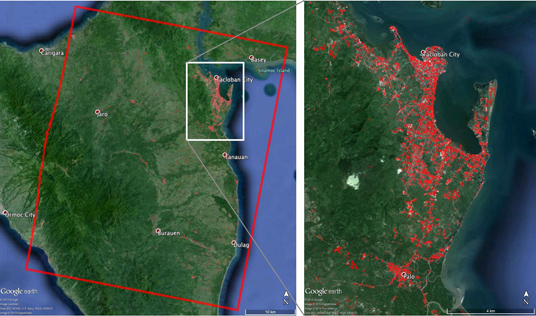Ask NASA Climate | November 19, 2013, 16:03 PST
Under the shadow of disaster
An emotional call for help

Damage map (40 by 50 km) showing the region near Tacloban City, where the massive storm made landfall. The image was made using synthetic aperture radar data from the Italian Space Agency's COSMO-SkyMed satellite constellation, processed by JPL's Advanced Rapid Imaging and Analysis (ARIA) team. Most of the damage and initial loss of life in Tacloban City was the result of a punishing 12- to 20-foot-high storm surge that were quite far inalnd, along with powerful winds near the coast.
Carmen Boening is a scientist in the Climate Physics Group at NASA’s Jet Propulsion Laboratory in Pasadena, California. She is reporting from the United Nations Climate Change Conference in Poland.
While we talk and listen here at COP19 [the United Nations Climate Change conference happening in Poland], and the politicians try to make headway in the climate treaty negotiations, the rest of the world lives on.
People in the Philippines are reeling from the devastating Typhoon Haiyan that hit the nation last week. Over 3,000 people are confirmed dead and thousands more injured and missing. In all, nine million people have been affected by the huge storm. The super typhoon was one of the most powerful storms ever recorded on Earth, with winds of around 195 mph (315 km/h).
The emotional speech given by Yeb Sano, the Philippines’ climate change representative, moved us all.
He described the damage left in the wake of Typhoon Haiyan as “unprecedented, unthinkable and horrific”. While he stopped short of saying that the storm was the direct result of climate change, he called for urgent action:
“Up to this hour, I agonize waiting to hear of the fate of my very own relatives…
I speak for my delegation, I speak for the countless people who will no longer be able to speak for themselves after perishing from the storm, I speak also for those who have been orphaned by the storm. I speak for those people now racing against time to save survivors...
We can take drastic action now to ensure we prevent a future where super typhoons become a way of life. Can we ever attain the ultimate objective of the [UN climate] convention, which is to prevent dangerous anthropogenic [human] interference with the climate system? By failing to meet the objective of the convention, we may have ratified our own doom.”
This massive weather event, like Hurricane Sandy and others, has again put the spotlight on science. Storms arise naturally and have existed since before man began to tinker with the climate. But is climate change affecting their frequency or strength? That's what we're trying to work out.
While it’s not possible to pin any one storm on climate change – at least not for now – the latest research seems to indicate that global warming is causing storms – which feed off warm ocean surface waters – to become more intense, with heavier rainfall and stronger winds. Stronger storms, combined with sea level rise, which leads to higher seas and bigger storm surges, cause more damage and devastation when they hit coastal places like the Philippines or New York.
Scientists around the world are now frantically trying to shed light on events like Typhoon Haiyan and decipher the link between extreme weather and climate change. It is difficult to track down the root cause of any one event, but climate scientists are expert at studying the trends. Discussions here at the conference are heated and understandably emotional, but we have to be careful not to jump to premature conclusions while the jury is still out.
The violence of Typhoon Haiyan shows the ravaging impact weather and climate can have on mankind. It stresses the need for us to get to know our planet better and how it reacts to our activities.
Towards the end of his speech, Sano declared that he was going on a voluntary hunger strike at the conference in solidarity with his brother who had not eaten for days in the wake of the typhoon. He said he wouldn't eat until a meaningful outcome is in sight and concrete pledges have been made. “We can stop this, we can fix this madness.”
While it’s clear that everyone here sympathises with the human tragedy unfolding in the Philippines, and the impact of other devastating storms we have seen in recent times, it remains to be seen whether or not that sympathy will translate into specific international plans to reduce climate change.
Related links:
